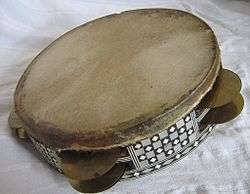Riq
 | |
| Other names | duff, mriq |
|---|---|
| Classification | hand percussion |
| Playing range | |
| High sound of jingles, with a skin with a lower sound. | |
| Related instruments | |
| tambourine, Buben, Dayereh, Daf, Kanjira, Frame drum | |
The riq (Arabic: رق) (also spelled riqq or rik) is a type of tambourine used as a traditional instrument in Arabic music. It is an important instrument in both folk and classical music throughout the Arabic-speaking world. It traditionally has a wooden frame (although in the modern era it may also be made of metal), jingles, and a thin, translucent head made of fish or goat skin (or, more recently, a synthetic material).
It is between 20 and 25 cm in diameter. Descended from the daf, like the tar, the riq acquired its name in the 19th century so that it could be differentiated.
The riq is played in takht ensembles (Egypt, Syria) or chalghi ensembles (Iraq) where it has a particularly clearcut role, going beyond the simple rhythmic requirements of the daf, tar, or mazhar. In Sudan, where it seems to have been introduced recently, the riq is also related to worship, as in upper Egypt.
The frame of the riq can be covered on both the inner and outer sides with inlay such as mother-of-pearl, ivory or decorative wood, like apricot or lemon. It has ten pairs of small cymbals (about 6 cm in diameter), mounted in five pairs of slits. The skin of a fish or young goat is glued on and tightened over the frame, which is about 6 cm deep. In Egypt the riq is usually 20 cm wide; in Iraq it is slightly larger.
Traditionally, frame drums have been used to support the voices of singers, who manipulate them themselves; but the player of the riq, like that of the doira of Uzbekistan, plays without singing. While the daff and the mazhar are held relatively still, at chest or face height, with the player seated, the riq, because of the use of different tone-colours, may be violently shaken above the head, then roughly lowered to the knee, and played vertically as well as horizontally. The player alternates between striking the membrane and shaking the jingles, and his need for freedom of movement necessitates that he stand up. Students of the instrument are required to master the technical problems imposed by the timbre of the membrane and the jingles, both separately and in combination; aside from developing a virtuoso technique they also need to learn the many rhythmic cycles and the techniques of modifying them through creative invention.
